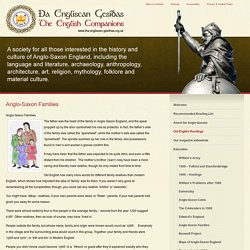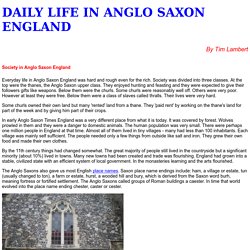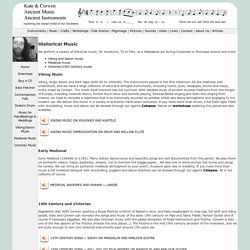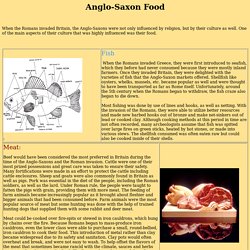

Anglo. Jeff Bond --Warfare Darryl Barfuss--Tactics Masson Emerson --Weaponry Anglo-Saxon warcraft: What were they thinking?

By Jeff Bond War was a way of life for many Anglo-Saxons. Before Battle The English and other Northern European cultures commonly used boasting to control their fear when anticipating a battle. During Battle To the Anglo-Saxons, a sword or a cuirass was more than just a useful lump of metal; they endowed their battle gear with totemic strength by fretting them with symbols and giving them names.
Anglo-Saxon helmets often featured decorations resembling boars made of gold and bronze. The feared berserker warriors of the pagan north demonstrate this principle taken to the extreme. Berserkers belonged to an elite order holy to Odin. Despite the widespread rationalism of our modern era, we continue that same practice even today. The same idea may have inspired the custom of naming weapons and armor. After Battle they could not have been killed and therefore ran from nothing.
Links: Primary History - Anglo-Saxons - Anglo-Saxons at war. Tha Engliscan Gesithas. Anglo-Saxon Families The father was the head of the family in Anglo-Saxon England, and the spear propped up by the door symbolised his role as protector.

In fact, the father’s side of the family was called the ‘sperehealf’, while the mother’s side was called the ‘spinelhealf’. The spindle summed up her role in the family, and possessions found in men’s and women’s graves confirm this. It may have been that the father was expected to be quite strict, and even a little distant from his children. The mother’s brother (‘eam’) may have been a more caring and friendly male relative, though he only visited from time to time. Old English has many more words for different family relatives than modern English, which shows how important the idea of ‘family’ was for them. You might have ‘stēop-‘ relatives, if your own parents were dead, or ‘fōster-‘ parents, if your real parents had given you away for some reason. Life in Anglo Saxon England. Everyday life in Anglo Saxon England was hard and rough even for the rich.

Society was divided into three classes. At the top were the thanes, the Anglo Saxon upper class. They enjoyed hunting and feasting and they were expected to give their followers gifts like weapons. Below them were the churls. Some churls were reasonably well off. Some churls owned their own land but many 'rented' land from a thane. In early Anglo Saxon Times England was a very different place from what it is today. By the 11th century things had changed somewhat. The Anglo Saxons also gave us most English place names. A Saxon church in Chichester Kinship (family ties) were very important in Anglo Saxon society. Primary History - Anglo-Saxons - Anglo-Saxon beliefs. Anglo-Saxon origins. The Witan The Witan was the occasion when the King would call together his leading advisors and nobles to discuss matters affecting the country.

It existed only when the King chose and was made up of those individuals whom he particularly summoned. Ancient Music ~ Kate & Corwen's Homepage. Historical Music We perform a variety of historical music, for museums, TV or Film, as a Walkabout act during Corporate or Municipal events and more: Viking Music Viking, Anglo Saxon and Dark Ages (600 AD to 1066AD).

The instruments played in the first millenium AD are relatively well understood, and we have a large collection of wind and stringed instruments, including horns, lyres, reedpipes, drums and harps, many made by Corwen. The music itself however has not survived. Early Medieval Early Medieval (1066AD to 1350). 19th Century and Victorian Napoleonic War. If you would like to book us for your museum, open day or other event, get in touch. Medieval Clothing. King Edgar from the New Minster Charter, Winchester, 966CE Just as wool formed the cornerstone of the early English economy, so was it the foundation of everyone’s wardrobe, high-born or low.

The vast majority of clothing was fashioned of this extraordinarily useful renewable resource shorn from sheep. Of secondary importance was the relative luxuriousness of linen, used for under clothing. Silk, exceedingly rare and costly, was limited to the very rich, and to the burials of the sainted. Manuscript painting offers the greatest number of illustrations of Anglo-Saxon garments, with the kings, queens, saints and clerics depicted in raiment appropriate to their respective classes. 8th-9th century King and Queen Unmentionables.
Anglo-Saxon Food. Fish When the Romans invaded Greece, they were first introduced to seafish, which they before had never consumed because they were mostly inland farmers.

Once they invaded Britain, they were delighted with the varieties of fish that the Anglo-Saxon markets offered. Shellfish like oysters, whelks, mussels, etc. became popular as well and were thought to have been transported as far as Rome itself. Unfortunately, around the 5th century when the Romans began to withdraw, the fish craze also began to die down. Most fishing was done by use of lines and hooks, as well as netting. Primary History - Anglo-Saxons - Anglo-Saxon life.